When your eating plan stops working, it’s normal to just feel… stuck. But you can fix almost any diet problem with these 3 steps. (The first one might really surprise you).
++++
I’ve been working in the fitness and nutrition field for 25 years so I can say with certainty that every eating plan breaks down eventually. Kids come along, jobs get busy, family members get sick… LIFE happens.
It’s easy — too easy — to get lost.
But the exact nature of these nutrition breakdowns can vary. So, over the past few years, I’ve worked hard to come up with a formula that’ll fix almost any diet problem.
See, the nutrition “advice” you usually hear in the media and at the gym is often boiled down to buzzwords and slogans. You know the ones:
- “Just eat whole foods.”
- “Only eat food that your grandmother would recognize.”
- “Eat more fat and fewer carbs.”
- “If it doesn’t run, fly or swim – or it isn’t a green vegetable – don’t eat it.”
But when you’re a real human in the real world — or a fitness professional helping one — slogans don’t get the job done.
Slogans lead to nutritional wheel spinning, frustration, and fat-loss plateaus — or even unwanted weight gain. They lead to:
Should I just quit already?
Why do I suck at this?
Will nutrition always come with frustration and failure?
It’s time to go beyond the clichés and discuss how to really help clients fix a broken diet and start eating better.
To share how we troubleshoot eating plans when they’ve “just stopped working” and you don’t know what else to try.
And, finally, to show you how to use these powerful and purposeful strategies to improve your own eating. Or to help others do the same.
These steps are proven to work — we’ve now tested them with close to 50,000 clients — and some of them may surprise you.
++++
By the way, I gave a seminar on this very topic to fitness professionals in London England not too long ago. Everyone I talked to afterward said the discussion opened their eyes to a more effective strategy for getting results.
Trust me: A better understanding of nutritional physiology will give you a leg up in the fitness game. (It may even get you excited about your career again).
Want a printable guide to go along with the video and accompanying article? Check this out: How to fix a broken diet: 3 ways to get your eating on track.
++++
Step 1:
Remove nutritional deficiencies
When diets stop working, most people assume they need a complete overhaul right away.
I have to cut out sugar… and dairy… and carbs… and saturated fat.
Plus I have to eat more protein… more healthy fats… and more vegetables.
I have to start drinking lots of water too.
And exercise… maybe a 6 am boot camp… yeah.
Let’s call it the Mission Impossible approach.
Through lots of frustration and failure in my early career, I realized that the Mission Impossible approach isn’t just difficult; it’s misguided.
Because a complete overhaul rarely addresses what’s keeping most people from eating well in the first place.
The problem is: People feel bad. And it’s really hard to find the effort that’s required for a healthy diet when you feel bad most of the time.
Now, I call the root sources of feeling bad “limiting factors”. Limiting factors are the things that stand in the way of progress. They could be physical, mental, emotional.
Let’s focus on the physical first.
Physical limiting factors could be hormonal imbalances or sleep deprivation or too much lifestyle stress. However, a very common — and very commonly overlooked — limiting factor is actually dietary deficiency: not getting the right nutrients, in the right amounts, to look and feel your best.
Shocking percentages of the U.S. population are deficient in major nutrients.
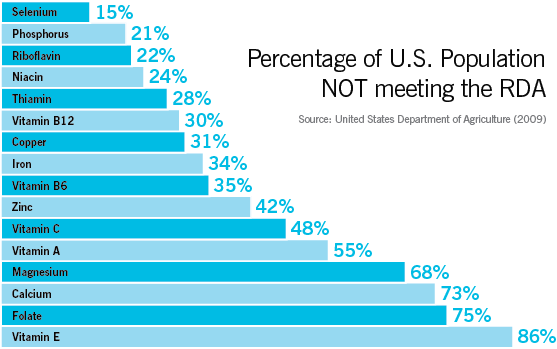
When it comes to deficiencies, a study published in the Journal of the International Society of Sports Nutrition backs this up: It’s really hard to get all the essential vitamins and minerals from food alone.
This study analyzed 70 athlete diets. Every single diet was deficient in at least three nutrients. And some diets were missing up to 15 nutrients! The most common deficiencies?
- iodine
- vitamin D
- zinc
- vitamin E
- calcium
Another study, also published in the Journal of the International Society of Sports Nutrition, showed that people following one of four popular diet plans (including Atkins, South Beach, and the DASH diet) were also very likely to be micronutrient deficient, particularly in six key micronutrients:
- vitamin B7
- vitamin D
- vitamin E
- chromium
- iodine
- molybdenum
Back when I was a graduate student at the University of Western Ontario, I set out to find the mythical “balanced diet.” I analyzed the intake of nearly 600 fourth-year exercise and nutrition undergraduate students.
Shockingly, less than 10 percent met the minimum standards for a “complete, balanced diet”. Like the other studies, these folks were missing such nutrients as:
- zinc
- magnesium
- vitamin D
- omega 3 fatty acids
- protein
In situations where populations are fed institutionally (i.e. prison inmates and school children) things can be even worse. But there’s hope.
Research in the British Journal of Psychiatry shows that providing fish oil and a multivitamin to prison inmates reduces aggressive and violent behavior by 35 percent and decreases antisocial behavior by 26 percent.
And a paper published in Nutrition Reviews shows that giving children fish oil and a multivitamin improves both their behavior and intelligence scores.
Bottom line: Dietary deficiencies are very common. Chances are, you’ve got one, no matter how good you think your diet is. At the same time, they’re not that hard to fix.
When you’re deficient in key nutrients, you feel bad.
As discussed above, optimized energy levels, appetite, strength, endurance, and mood all rely on getting enough essential nutrients.
That’s why you can eat “clean”, go Paleo, avoid meat, lower your carbs, or count calories – you can do “everything right” nutritionally – and still feel awful.
The most common deficiencies we see with new Precision Nutrition clients are:
- water (low-level dehydration)
- vitamins and minerals
- protein (particularly in women and in men with low appetites)
- essential fatty acids (95 percent of the population is deficient here)
The thing is, in the modern world, fixing a deficiency is pretty easy.
To find out if you (or your clients) are deficient in any area, there are a few options:
- Have a dietitian do a diet analysis.
- Record what you’re eating and enter it into an online nutritional calculator.
At Precision Nutrition, we like to make it even easier. As soon as clients begin with us, we do a quick survey of what they’re eating. Six questions tell us most of what we need to know. From there, we help them:
- eat more of the protein-rich foods they prefer;
- drink more hydrating fluids;
- supplement with essential fats (fish or algae oil); and/or
- eat more foods rich in the vitamins and minerals they need most.
As soon as they get these nutrients, they start getting results.
Our clients quickly start feeling better:
- Immediately energy levels go up.
- They feel more motivated.
- They lose fat and gain lean muscle.
- Their workouts become easier and better.
They start seeing the results that stopped when their diets “broke”.
In the end, the first step to fixing dietary problems is to identify and remove nutritional deficiencies.
Step 2:
Adjust food amount and food type
Once we’re getting all the raw materials necessary for proper functioning (i.e. essential nutrients) we can move on to bigger issues:
- food amount (what some call calorie intake); and
- food composition (which includes macronutrient breakdown).
In our coaching programs we help clients get away from using handbooks, websites, databases, spreadsheets, and math when planning meals.
You see, while we know that total food (calorie) intake matters, we’re not really fans of counting calories (for most people, most of the time).
To begin with, calorie counting does nothing to help us tune into our own powerful hunger and appetite cues. By learning how to listen to our own bodies, we have better long-term success in healthy eating.
(Of course, not everyone knows how to do this from the start. It takes a little coaching and some practice.)
Nor does calorie counting help us balance our health goals with our natural human enjoyment of food. In the short term, anyone can turn eating into a numerical and robotic exercise. But, in the long run, this strategy falls apart.
(Just ask anyone who “used to” count calories. You shouldn’t have a hard time finding them.)
There’s another problem with calorie counting: It’s just not all that accurate.
Because of imprecise labeling, lab errors, and differences in food quality and preparation, calorie counts recorded on food labels and websites – even those within the USDA’s nutrient databases – can be off by as much as 25 percent.
Then there’s the fact that human absorption is so wildly variable based on food preparation methods, and even the bacteria living inside your gut.
(If you really want to geek out with me, you can read this killer piece about how metabolism works. There are great sections on both the calories in and calories out sides of the energy balance equation.)
Bottom line: Even if you’re the world’s best calorie counter (and you can avoid the inevitable lifestyle problems associated with it) the math just doesn’t add up.
We teach most clients a different approach to calorie control.
The PN method for estimating portions requires nothing more than your own hand as the ultimate, portable measurement tool.
For example, men might begin by eating:
- 2 palms of protein dense foods at each meal;
- 2 fists of vegetables at each meal;
- 2 cupped handfuls of carb dense foods at most meals; and
- 2 thumbs of fat dense foods at most meals.
And women might begin by eating:
- 1 palm of protein dense foods at each meal;
- 1 fist of vegetables at each meal;
- 1 cupped handful of carb dense foods at most meals; and
- 1 thumb of fat dense foods at most meals.
First, we help clients see what this looks like. Like, in real life. On a plate.
Then, we adjust actual portion sizes up or down, depending on each person’s unique body and goals. For example:
- Men who want to add mass fast get an extra thumb of fat or an extra cupped handful of carbs per meal.
- But men who want to lose fat might scale down to 1 palm of protein, 1 thumb of fat, and 1 cupped handful of carbs per meal, eaten slowly and mindfully to 80 percent full.
Of course, just like any other form of nutrition planning – including detailed calorie counting – this is just a starting point.
You can’t know exactly how your body will respond in advance. So stay flexible and “steer dynamically”. Adjust your portions based on your hunger, fullness, overall activity level, and progress towards your goals.
Start with the basic template and then adjust your portions at any time using outcome-based decision-making, aka: “How’s that working for you?”
For 9 in 10 people, eliminating nutrient deficiencies and getting food portions right will make a huge difference in how they look and feel.
However, for those who want to go further – because they have more advanced goals or because they’re already doing the first two and still struggling – let’s talk about food composition.
At Precision Nutrition, we have a really simple shortcut for helping people “eat right for their body type”.
We begin by classifying clients into one of three general categories (or somatotypes):
- I types (ectomorphs),
- V types (mesomorphs), and
- O types (endomorphs).
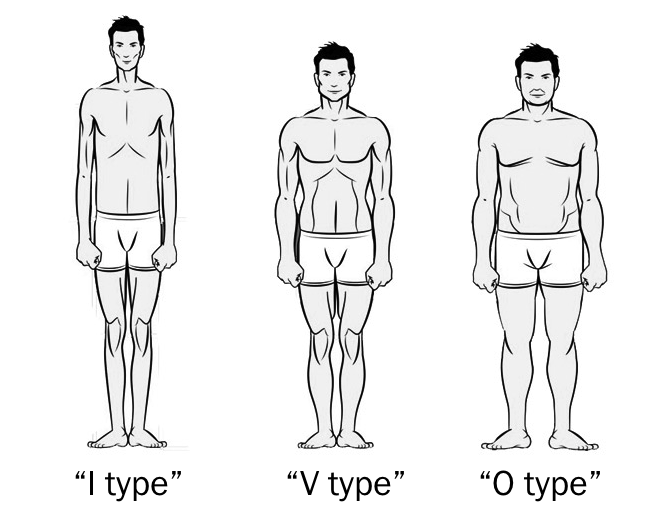

Nutrition for “I types”
I types (ectomorphs) are thin, with smaller bone structures and thinner limbs. Think of a typical endurance athlete. And they have a few key features that affect their response to food:
- Their engine speed is set to “high revving”. They tend to be thyroid- and sympathetic nervous system-dominant with either a higher output or higher sensitivity to catecholamines like epinephrine and norepinephrine. They typically have a fast metabolic rate.
- They’re high-energy. They’re often fidgeters and pacers. They tend to burn off excess calories with near-constant movement throughout the day.
- They tolerate carbs well. These are the rare folks who can seem to eat cookies with impunity.
I types therefore generally do best with more carbohydrates in the diet, along with a moderate protein and lower fat intake. So that’s what we recommend: more healthy carbs and less fat with a moderate amount of protein.
A nutrient distribution for this body type might be around 55 percent carbs, 25 percent protein, and 20 percent fat. (But don’t drive yourself crazy with the math. Just think “higher carbs and lower fat.”)
Here’s what that might look like using our portion control guide.
I type men begin by eating:
- 2 palms of protein dense foods at each meal;
- 2 fists of vegetables at each meal;
- 3 cupped handfuls of carb dense foods at each meal;
- 1 thumb of fat dense foods at each meal.
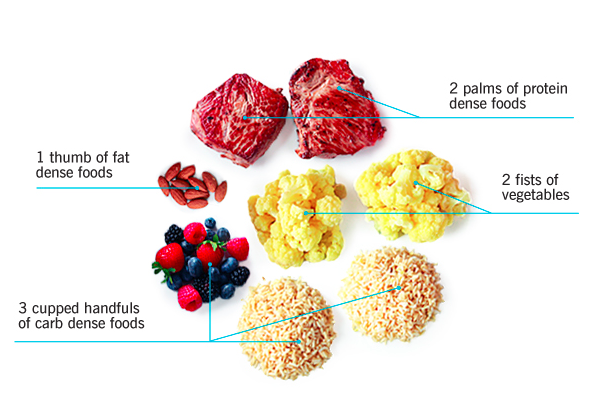
I type women begin by eating:
- 1 palm of protein dense foods at each meal;
- 1 fist of vegetables at each meal;
- 2 cupped handfuls of carb dense foods at each meal;
- 0.5 thumb of fat dense foods at each meal.
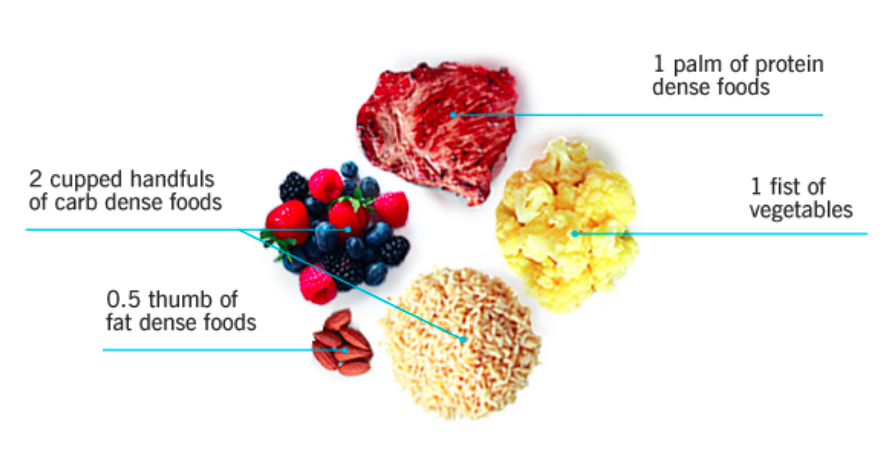
Nutrition for “V types”
V types (mesomorphs) have a medium sized bone structure and athletic body, and if they’re active, they usually have a considerable amount of lean mass. Many explosive athletes like wrestlers and gymnasts fit these criteria.
- Their bodies are designed to be powerful machines. Excess calories often go to lean mass and dense bones.
- They tend to be testosterone and growth hormone dominant.
- Thus, they can usually gain muscle and stay lean easily.
V types therefore generally do best on a mixed diet, with balanced carbohydrates, proteins, and fats. So that’s what we recommend.
A nutrient distribution for this body type might be around 40 percent carbohydrate, 30 percent protein, and 30 percent fat. (Again, don’t drive yourself crazy with the math. Just envision a roughly balanced mix of all three macronutrients.)
Here’s what that might look like using our portion control guide.
V type men begin by eating:
- 2 palms of protein dense foods at each meal;
- 2 fists of vegetables at each meal;
- 2 cupped handfuls of carb dense foods at each meal;
- 2 thumb of fat dense foods at each meal.
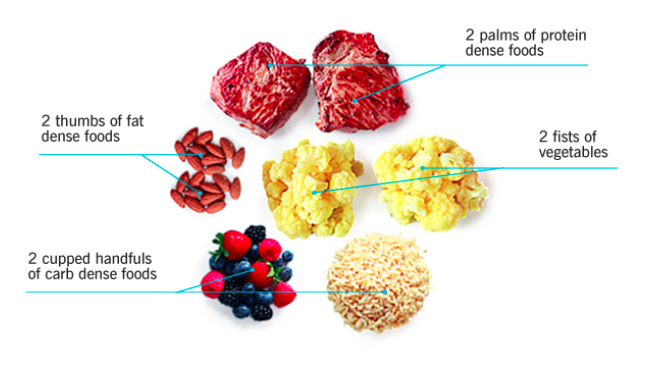
V type women begin by eating:
- 1 palm of protein dense foods at each meal;
- 1 fist of vegetables at each meal;
- 1 cupped handfuls of carb dense foods at each meal;
- 1 thumb of fat dense foods at each meal.
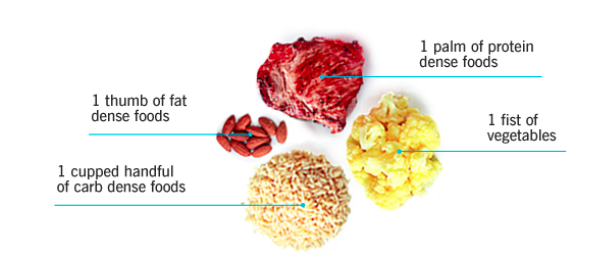
Nutrition for “O types”
O types (endomorphs) have a larger bone structure with higher amounts of total body mass and fat mass. Football linemen, powerlifters, and throwers are typically endomorphs.
- Their engine speed is set to “idle”. They tend to be parasympathetic nervous system dominant. Unlike ectomorphs, endomorphs are built for solid comfort, not speed.
- They’re naturally less active. Where the ectomorphs tend to burn off excess calories with near constant movement, excess calories in endomorphs do not seem to cause that same increase in expenditure. This means that excess calories are more likely to be stored as fat.
- They typically have a slower metabolic rate and generally don’t tolerate carbohydrates as well, particularly if they are sedentary.
O types therefore generally do best on a higher fat and protein intake with carbohydrate intake being lower and properly timed (e.g., mostly after exercise). So that’s what we recommend: more fat and protein, less carbohydrate.
A nutrient distribution for this body type might be around 25 percent carbs, 35 percent protein, and 40 percent fat. Again, no math gymnastics. Just think higher fats and protein, lower carbs.
Here’s what that might look like using our portion control guide:
O type men begin by eating:
- 2 palms of protein dense foods at each meal;
- 2 fists of vegetables at each meal;
- 1 cupped handful of carb dense foods at each meal;
- 3 thumbs of fat dense foods at each meal.
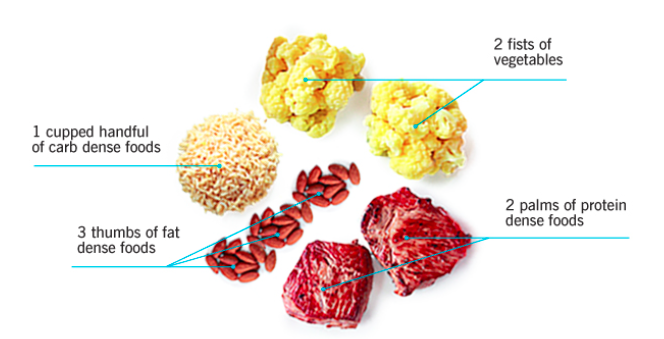
O type women begin by eating:
- 1 palm of protein dense foods at each meal;
- 1 fist of vegetables at each meal;
- 0.5 cupped handful of carb dense foods at each meal;
- 2 thumbs of fat dense foods at each meal.
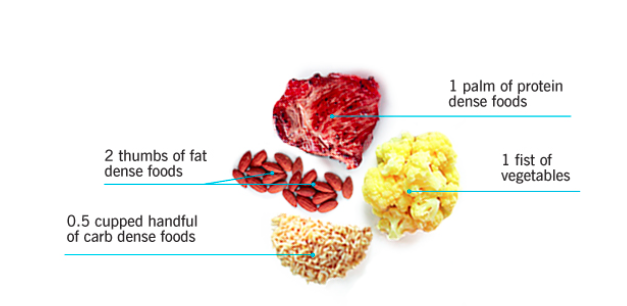
Step 3:
Fine tune the details
In the grand scheme of things, details like meal frequency, calorie/carb cycling, and workout nutrition – are just minor tweaks. Very minor tweaks. But let’s address them anyway.
Meal frequency
For years dietitians and nutritionists (myself included) thought that the best approach to splitting up your daily food intake was to eat small meals frequently throughout the day.
From early research we assumed that this would speed up the metabolism, help control the hormones insulin and cortisol, and help better manage the appetite. However we now know better.
All the latest research suggests that as long as we eat the right foods in the right amounts, meal frequency is a matter of personal preference.
You can eat lots of small meals each day (i.e. every few hours). Or you can eat a few big meals each day (i.e. with bigger time gaps between them).
Now, my advice is: Listen to your own body and apply the “how’s that workin’ for ya?” test.
If you’re covering all your other bases and your current meal frequency isn’t “workin’ for ya”, try switching it up. Experiment with fewer meals if you eat more frequently. And more meals if you eat less frequently.
Because either approach is valid, you’re free to find the approach that works best for you.
Calorie and carb cycling
Whether your goal is to lose weight, build muscle, see your abs, or get back in shape, carb and calorie cycling can make a real difference.
(Make sure deficiencies are eliminated, calories are controlled, and macronutrients are aligned appropriately – and that you’re doing all of this consistently before considering any of these fine-tuning strategies.)
While it may have a fancy name, carb cycling is simply eating more carbohydrates on some days – usually on high volume or high intensity days – and eating fewer carbohydrates on other days – usually low volume, low intensity, or off days.
We focus on carbohydrates (and not protein or fats) because carbs seem to influence body composition, how you look, and how you feel the most.
By changing carbohydrate and therefore calorie intake on particular days, we can keep fat loss going and metabolic rate humming along, without the ill effects of stringent calorie or carb restriction.
The carb and calorie cycling approach is pretty simple, and based on your activity.
- On the days you’re not lifting weights – or days you’re just doing low intensity or short duration exercise – eat a baseline diet of mostly protein, vegetables and healthy fats with minimal carbs.
- On the days you are lifting weights – or you’re doing longer duration high intensity exercise – add starchy carbs to your baseline diet.
And that’s pretty much it. No need to measure grams or count calories. Just follow a baseline diet on lower carb days. And add carbs on higher carb days.
Just remember this: Removing deficiencies, controlling calorie intake, and beginning eating for your body type – and doing this all consistently – must come first. If you haven’t done those first, this strategy usually backfires.
Workout nutrition
What should you have before, during, and after your workout?
If you’re training specifically for maximal muscle adaptation, and/or training with high volume and intensity (potentially multiple times every day), then eating an appropriate meal about 1-2 hours before and after training or competition may be important.
Also, for more advanced individuals, using a branched-chain amino acid drink (which is lower in carbs and calories), or a protein plus carbohydrate drink (which is higher in carbs and calories), during training can make a real difference in terms of adaptation and recovery.
However, if you’re exercising for general health and fitness – or simply to look and feel better – you should only consider the question of workout nutrition once you’ve:
- eliminated deficiencies;
- gotten your total food intake in check; and
- started eating right for your body type.
And — might I gently remind you — done all the above consistently. Yes, every day. Over and over and over.
Then if you’re still looking for a little boost, my best recommendation is to continue to eat normally around your workout. And use a simple branched chain amino acid (BCAA) supplement. Five-15 grams mixed in a liter of water and sipped during an exercise session should do the trick.
What to do next:
Tips from Precision Nutrition
If you’re frustrated with an eating plan that’s not working – but aren’t sure what to do about it – hopefully this article has given you something new to consider and try.
1. Remove “limiting factors”.
If you feel bad, no diet is going to work for you. So start by rooting out and eliminating “limiting factors”. This includes addressing any sleep problems and talking to your doctor if you feel there may be a hormone imbalance.
But the most common — and commonly overlooked — problem is nutritional deficiency. And the easiest way to wipe it out is by:
- eating more protein-rich foods;
- drinking more hydrating fluids;
- supplementing with essential fats (fish or algae oil); and/or
- eating more foods rich in the vitamins and minerals you need most.
2. Calibrate food amount and type
Make sure you (or your clients) are eating the right kind and amount of food.
Start with the hand-measure portions for men in women in our Calorie Control Guide. (For fitness pros: Feel free to print out our infographic on portions for your clients).
From there, adjust portions based on appetite, meal frequency, activity level, weight goals, and results.
Then, if you feel the diet could be further tailored, consider adjusting portions for your body type.
3. Be consistent.
With these strategies, you should get results relatively quickly in most cases. But not overnight, and not if you’re inconsistent.
The key to staying consistent while fixing a broken diet: accountability. That could mean a food journal, a trainer, a trusted partner or friend, or an experienced nutrition coach.
Want more help?
Improving your diet and health while meeting the other demands in your life can feel a little overwhelming. At Precision Nutrition, it’s our mission to help make the process easier.
Women and men in our Precision Nutrition Coaching programs learn how to optimize their food intake and activity levels to achieve their goals in sustainable, long-term ways.
And fitness and health professionals in our Level 1 and Level 2 Certification programs learn how to help their clients do the same.
Coming .
If you’re a health and fitness pro and would like to learn more about becoming an elite, world-class nutrition and lifestyle coach, check out our Precision Nutrition Level 1 Certification program; it kicks off soon.
Important: Since we only take a limited number of students each time we offer the program, and it sells out every time, the best strategy is to add your name to our free presale list.
Getting on the list gives you the chance to sign up for the certification 24 hours before everyone else. Even better, you save big on the cost of the program.
[Of course, if you’re already a student or graduate of the Level 1 Certification, check out our Level 2 Certification, an exclusive Master Class for elite trainers looking to perfect their nutrition knowledge and coaching techniques].
References
Click here to view the information sources referenced in this article.
The post The 3 steps I teach trainers and health coaches to help fix any diet problem. appeared first on Precision Nutrition.
from Blog – Precision Nutrition http://www.precisionnutrition.com/fix-any-diet-problem
via Holistic Clients
No comments:
Post a Comment